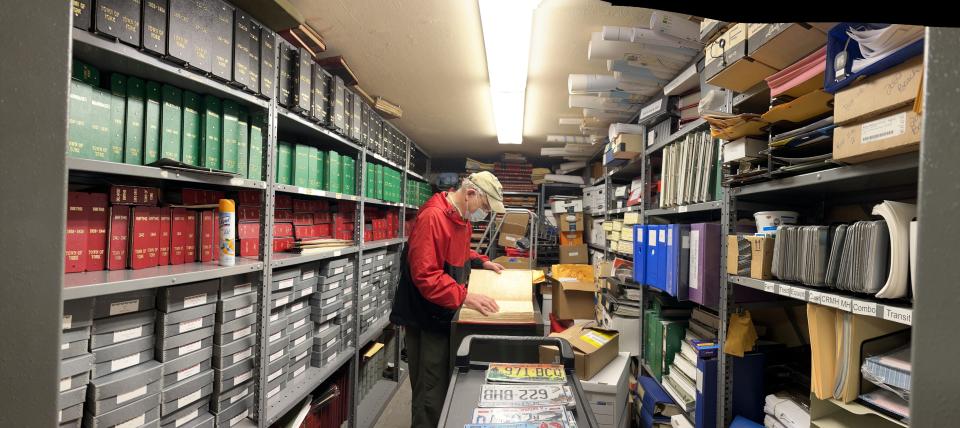Column: York Town Hall records vault is home to priceless gems of history
- Oops!Something went wrong.Please try again later.
"I am here to…" Many times, over the course of a given day, a visit to the town clerk's office begins with this brief announcement of intention. Perhaps it is to obtain a license or to register a vehicle. There is a long list of possibilities. And that list has grown longer with time, parallel with the layering of regulations by governments at the county, state, and federal levels.
The documents that are drafted become part of the permanent record- a record that must be carefully preserved, and properly stored. That is the purpose of the vault that is located in the office. Successive generations of town residents who have been compelled to take a few minutes out of their day for a visit to the town clerk, when measured in thousands, have created the constant influx of items into the finite space of the vault, that by now has reached capacity.

The current vault appears to have been installed in the late 1970s; at the annual town meeting in March 1976, the electorate voted to approve a $45,000 appropriation that was to result in the placement of the town clerk and tax collector's office, together with "a fireproof vault for the storage of irreplaceable records,” on the lower floor of the town hall.
But this is only the most recent effort, as there have been others for more than a century. From the York Courant, June 1892, comes this brief report, "the brick masons have been for the past week building a vault in the town house for the disposition of the town records." Four decades later, in 1936, Article 44 at the town meeting, again made reference to the need for a vault for the records, but nothing came of it. In 1957, $500 dollars was sought for the purchase of a safe.
The problem of a vault of sufficient size to allow for an expanding mass of new records while at the same time providing room for historical records hundreds of years old is undoubtedly being faced by numerous New England towns. But what is different from the rest, is York's Town Hall is at its core over 200 years in age, dating from the presidency of James Madison, the fourth President of the United States.
This is indeed a remarkable building that has been witness to some of the most important events in American history, or more correctly, a witness to how the community experienced those events. The majority who walk through the doors rarely give much consideration to that truth. For them, it is a public building, the location of local government offices in York Village on York Street close to the First Parish Church. But it is very much more than that.
From the letters and diaries, the newspapers, episodes in its life are brought to view that reveal just how extraordinary that life has been. It has been the setting for lectures and dramatic performances, musical concerts, and athletic activities. The building has served as something of a cultural center from the nineteenth century, even before it assumed its formal role as the town hall.
"Attended a concert in the evening at the courthouse," Charles O. Clark wrote in his diary in September 1859. It would not be until a decade later the building would take on the name of town house. There does not seem to have been any other place in town where so many could be fit into a large room, and that might be how it began to assume that purpose.
"Gen. Chamberlain gave his lecture on the surrender of Lee tonight in the town hall," Joseph Bragdon, another diarist wrote in December 1883. The presentation by the distinguished former commander of the famed 20th Maine Regiment, was just one of the many others that Bragdon attended, and all of them occurred at the town hall.
Playbills and broadsides offer additional insights into past events. In March of 1916, a year prior to the entry of the United States into the First World War, "A Suffragette Town Meeting," in which women took the part of men in the various offices of town government, was followed a week later by a performance of "The Octoroon."
In 1910, a reference to the stage and scenery is encountered in the records, and it was also at that time the first electrical wiring was introduced. The building has had to adapt to the changes in technology- from the innovation of electric lights in the first decade of the twentieth century, to computerization before the century ended.
The quandary of the records vault that has reached its capacity, is but another dimension of the all-embracing quandary of a two-century-old building being expected to endure the demands of the modern twenty-first-century world being imposed upon it, despite the many signs that the building like the vault has also approached its limits.
York is fortunate that the proposed brick town hall of 1929 was never permitted to become a reality. As period photographs clearly show, the exterior of the building looks much the same as it did a century in the past. How many towns could make such a claim, and how many towns wish they could? This is something for all of us to ponder over in our awe of this place where so much has happened.
James Kences is the new town historian for the town of York. In this essay, he makes an urgent plea: the vault in the town has become full and needs to be expanded.
This article originally appeared on Portsmouth Herald: Column: York Town Hall records vault is home to priceless gems of history

